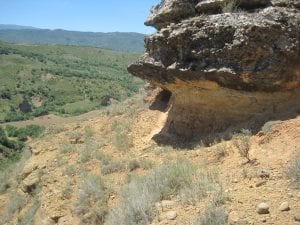Some reflections by my co-authors and me on our recent paper in Earth and Planetary Science Letters, showing that ancient global warming was associated with an increase in the number of extreme rainfall events and this had a profound impact on the land and coastal seas.
The Palaeocene-Eocene Thermal Maximum (PETM), which occurred about 56 Million years ago, is of great interest to climate scientists because it represents a relatively rapid global warming event, with some similarities to the human-induced warming of today. Although there have been many investigations of how much the Earth warmed at the PETM (about 5 to 8C), there have been relatively few studies of how that changed the hydrological cycle. This newly published work shows that rainfall increased in some places and decreased in others, according to expectations, but that much of the world experienced more intense and episodic (or ‘flashy’) rainfall events.
Lead author Matt Carmichael (School of Chemistry and School of Geographical Sciences) explained: ‘With the same climate models used to study future climate change, we studied how a doubling of carbon dioxide concentrations would affect rainfall patterns on a world with Eocene geography. This increased the overall global precipitation – warmer air holds more water. But it also changed the pattern and frequency of extreme events. The tropics became wetter and the incidence of extreme events increased, by as much as 70% in some tropical regions. In other places, total annual precipitation and the number of extreme events became decoupled; in other words, those areas became drier, with less frequent but more extreme events. All of this illustrates the complexity of how global warming will affect our local, regional and global rainfall patterns.’
Co-author Professor Rich Pancost (School of Earth Sciences), explained how these findings agree with a range of geological and chemical features of the Palaeocene-Eocene global warming: ‘This warming event is associated with major changes in how soil and sediment were eroded and moved around the landscape. In many places, river systems that had been transporting silt or sand became associated with fist-sized rocks or even boulders; and more sediment was transported to and buried in coastal margins. In some locations, the rate of sediment accumulation increased by a factor of ten. But at the same time, there is also evidence that these systems became more arid. Our climate simulations reconcile this; many locations do experience an increase in aridity but also more intense rainfall events. Those events were likely responsible for increased energy in these systems, moving around more material and larger objects. Ultimately it flushed more sediment to the ocean, causing eutrophication, blooms of algae and in some cases hypoxia.’ [Analogous but less severe than Oceanic Anoxic Events.]
Photo of the Claret Conglomerate by Rob Duller, University of Liverpool. I wrote about this here: “In central Spain, outcropping on dusty hillsides overlooking apparently endless miles of gnarled olive trees, is the Esplugafreda Formation. The Formation consists of hundreds of metres of rusty-coloured palaeosols and the remains of ancient channels, part of a more-than-55-million-year-old braided river system. What is particularly striking about these rocks is that atop them sits the Claret Conglomerate, a unit not of silt, sand and ancient soil, but of pebbles, fist-sized stones and even boulders. These stones are part of the same river system but were deposited under conditions with far more energy: the Conglomerate represents a relatively transient moment in Earth history of remarkably intense rainfall events. And these events were probably caused by ancient global warming.”
Co-author Professor Dan Lunt (School of Geographical Sciences) elaborated on this: ‘There are many similar events in Earth history, where warming appears to have been associated with changes in rainfall and sedimentary systems. Although we have not investigated them here, it is very likely that our results are translatable – because the physics that underpins them remains the same. Thus, the collective body of research confirms that global warming in the past and the future will be associated with more ‘flashy’ rainfall, with implications for flooding and water management.’
Professor Pancost elaborated: ‘Past climate has lessons for our future. Not only do the models show evidence for more intense rainfall events – with all of the associated implications – but they are consistent with all of our other data. In fact, they explain inconsistencies in our other data and confirm some long-established hypotheses. In doing so, they foreshadow our potential future with complex and dramatic changes in rainfall, more flooding and more soil erosion.’
Response of the hydrological cycle to doubling of carbon dioxide concentrations:

From the paper: Figure a shows the expected impact of a doubling of CO2 on global precipitation patterns – dry areas get drier and wet areas get wetter. However, (b) shows that the number of actual precipitation events decreases almost everywhere. Both (c) and (d) show different mathematical expressions of ‘extreme’ events, and both show that nearly global increase in the number of extreme events.
The article is: Carmichael, M., Pancost, R.D. and Lunt, D.J. (2018) Changes in the occurrence of extreme precipitation events at the Paleocene-Eocene thermal maximum. Earth and Planetary Science Letters 501, 24-36.
It is available here: https://authors.elsevier.com/sd/article/S0012821X18304643


